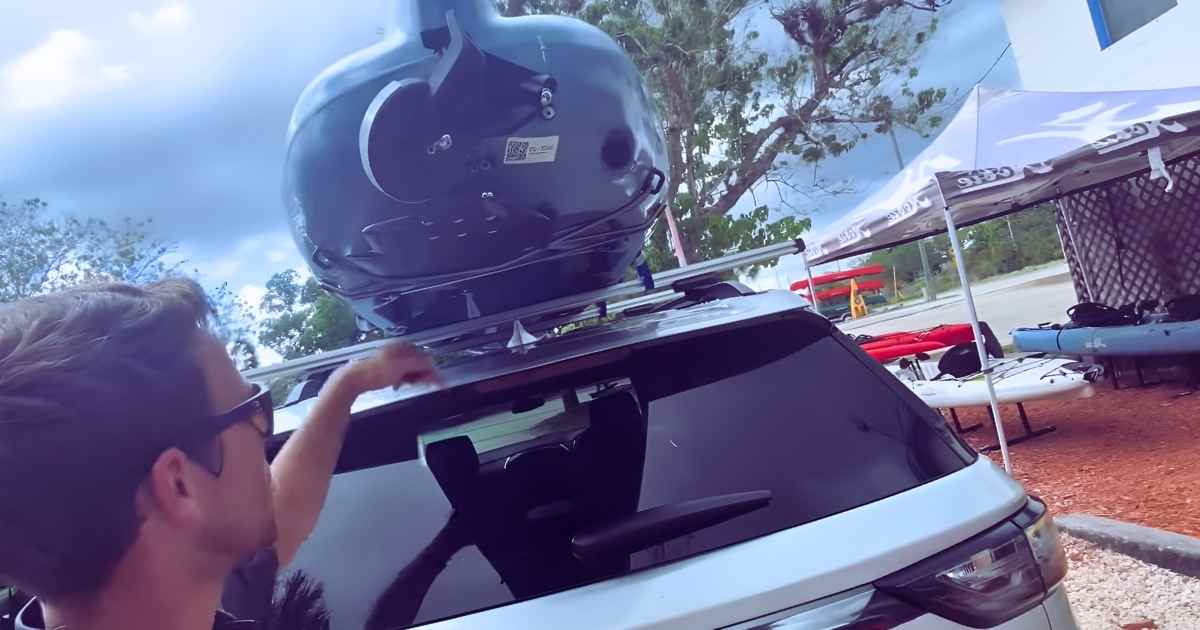Transporting a kayak can feel like a puzzle, especially when you’re new to it. With different methods to choose from, it’s easy to get overwhelmed.
But what about transporting it upside down? Should a kayak be transported upside down? The simple answer is yes. While it may seem strange at first, it’s actually the best way to keep it safe during transportation.
When you transport a kayak upside down, the hull of the kayak remains elevated and protected from scratches and other potential damages.
This simple trick works like magic and helps keep your kayak strong and lasting for a long time.
It is a clever solution and the key to ensuring its safety during transportation. In fact, this method offers a range of advantages over transporting it upright.

Contents
Why Should You Transport A Kayak Upside Down?
When it comes to transporting your kayak, you might wonder why you should transport it upside down. And there are other ways as well.
So, in the following section, we’ll compare transporting upside down with the right side up. And explore reasons why it’s a good decision.
However, it is important to note that not all kayaks are designed to be transported upside down. Some kayaks have features, such as hatches, that are not watertight when upside down.
Additionally, some kayaks have fragile components, such as rudders or skegs, that can be damaged if transported upside down.
So, you’ll need to check the manufacturer’s recommendation first.
Let’s explore the comparison and find out why you should transport a kayak upside down.
Aerodynamics
One of the main reasons why kayaks are transported upside down is aerodynamics. When a kayak is transported right side up, the wind can catch the hull and create lift. This lift can cause the kayak to become unstable and even fly off the roof rack.
But when you transport the kayak upside down, the wind flows smoothly over the bottom part, called the hull. This reduces the lift and makes the kayak more stable during transportation.
Stress Distribution


Another reason to transport your kayak upside down is stress distribution. When a kayak is transported right side up, the weight of the kayak is concentrated on the centerline of the roof rack. This can cause stress points on the kayak and potentially damage it over time.
When you transport the kayak upside down, the weight is distributed evenly across the entire roof rack, reducing stress points and prolonging the life of your kayak.
Added Safety
Transporting a kayak upside down is the safest way to transport it. When a kayak is transported right-side up, it is more susceptible to wind and can easily catch air, causing it to lift off the carrier. This can be dangerous, especially when driving at high speeds. Additionally, if the kayak is not secured properly, it can shift and cause an accident.
On the other hand, when a kayak is transported upside down, it is more aerodynamic and less likely to catch air. This makes it more stable and less likely to shift during transport. Furthermore, when the kayak is upside down, the cockpit rim and the deck are protected, reducing the risk of damage during transport.
Longevity Of The Kayak
Transporting a kayak upside down can also increase the longevity of the kayak. When a kayak is transported right-side up, the weight of the kayak is resting on the hull, which can cause deformation over time. This can lead to structural damage and reduce the lifespan of the kayak.
However, when a kayak is transported upside down, the weight of the kayak is distributed evenly across the cockpit rim and the deck. This reduces the risk of deformation and structural damage, which can increase the lifespan of the kayak.
Advantages Of Transporting A Kayak Upside Down
Transporting a kayak upside down offers several advantages that ensure the safety and convenience of your watercraft. Let’s explore these benefits:
Protection Of The Kayak’s Hull


Transporting the kayak upside down is a simple but good way to protect it from scratches and potential damage. It keeps the hull strong and in good shape for a long time.
The hull is more exposed to potential damage if you carry the kayak right-side up. It can rub against rough surfaces and roof racks. This may result in unsightly scratches.
But when you flip it upside down and transport it, the hull stays up in the air and doesn’t touch rough things. This helps avoid scratches and dings. And it’s effective to maintain the structural integrity of your kayak.
Secure And Stable Positioning


Setting the kayak upside down has some good benefits for keeping it secure and steady.
The kayak fits snugly on the roof rack when it is upside down. So it doesn’t move or wobble too much while you’re transporting it. And it is necessarily important to avoid accidents and prevent any damage.
Additionally, this spread out the kayak’s weight evenly on the roof rack. This even weight distribution helps keep the kayak balanced and steady while you’re moving. It lowers the chances of it shifting or sliding during the journey.
Easy Loading And Unloading
When you transport a kayak upside down, loading and unloading it onto the roof rack becomes much easier. Since the kayak is flipped over, the hull is facing upward. This means you don’t have to worry about aligning the kayak perfectly or struggling to position it in a specific way.
Additionally, when it’s time to unload the kayak, you don’t have to worry about maneuvering it in a specific way to get it off the roof rack. You can slide it off the rack without any complicated maneuvers.
Reducing Wind Resistance
When transported upside down, the smooth hull of the kayak stays upright to the oncoming wind. This positioning offers an advantage by reducing wind resistance and minimizing drag.
Roof Rack Compatibility: A Potential Drawback
Some roof rack systems may need to be more suitable for upside-down transportation. It’s important to check the compatibility of your roof rack and ensure it provides proper support for an upside-down kayak.
5 Tips For Transporting A Kayak Upside Down
Transporting a kayak upside down can be a great way to keep it safe and secure during your journey. Here are five important tips to remember when transporting your kayak upside down.
Tip 1: Get Your Roof Rack Ready
Before loading your kayak, ensure your roof rack is clean and free from any dirt or debris. Check that it’s in good shape and can handle the weight of your kayak.
Add extra padding or special accessories to give your kayak some extra support.
Tip 2: Use Strong Straps
Strong straps and tie-downs are important to secure your kayak properly for a safe journey. Use high-quality straps and tie-downs that are made specifically for kayaks. Make sure the straps are in good condition and not worn out.
When you attach them, make them tight enough to hold your kayak securely but not too tight that they cause any damage. Before you start driving and during the trip, check the straps to make sure they’re still tight.
Tip 3: Protect The Kayak’s Hull
Protect the kayak’s hull. Consider using something soft and protective to keep your kayak’s hull safe from scratches and damage.
You can use a special guard made just for kayaks or even a soft blanket or foam padding. Put it between the kayak and the roof rack to give it a little cushion.
This will help prevent any scratches or marks caused by rubbing or vibrations.
Tip 4: Balance The Weight
When you load your kayak upside down, try to distribute the weight evenly on the roof rack. This is important for keeping your vehicle stable and safe while you’re driving.
If the weight is all on one side, it can make your vehicle tilt or the kayak move around.
Make sure to follow any weight capacity limits from the manufacturer and adjust the kayak’s position if needed.
Tip 5: Check The Height And Secure Loose Parts
Before you hit the road, check your vehicle’s height to ensure it can fit with the kayak on top.
Watch out for places like bridges or parking garages that might have low clearance.
Also, make sure any loose parts on the kayak, like paddles or fishing gear, are secured tightly. You can use bungee cords or tie them down so they don’t fall off during the trip.
Learn More
Is It Easy To Load A Kayak Upside Down?
Yes, loading and unloading a kayak upside down is generally easy and doesn’t involve additional hassle.
Is It Safe To Secure A Kayak Upside Down?
Yes, it is safe to secure a kayak upside down during transportation. In fact, securing a kayak upside down offers several advantages.
Just ensure you use high-quality straps or tie-downs designed for kayak transportation.
Final Words
So, transporting a kayak upside down is the safest and most effective way to transport it. It reduces the risk of damage to the kayak and increases its lifespan. But make sure to secure the kayak properly before transport and double-check that it is upside down before hitting the road.



